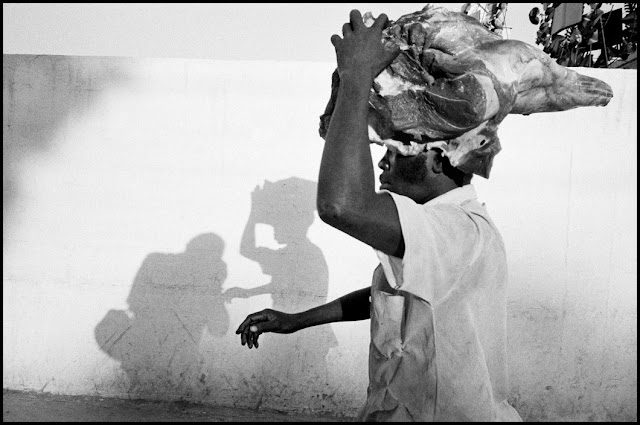 |
Haiti. By Bruce Gilden.
|
Photographs by Bruce Gilden
Atelier EXB, 2023. 144 pp., 75 illustrations, 8½x11½".
At first blush, Bruce Gilden photographing Haiti does not seem like a fair fight. With a confrontational style honed on the gritty sidewalks of New York City, Gilden has a reputation as an aggressive and in-your-face street shooter. "I'm known for taking pictures very close,” he boasts, “and the older I get, the closer I get." His proximity is often exacerbated by surprise attacks and off-camera flash, with provocative results.
Haiti, meanwhile, has been a geopolitical punching bag for centuries. It has suffered under the clumsy mismanagement of various governments, strongmen, and paramilitary organizations, plagued by US meddling, resource depletion, corruption, and poverty. Its poor citizens would seem to have enough on their plate already without a Magnum photographer poking around their affairs. Throw in the fact that he’s a white interloper from the most powerful country on earth, and Haitian photo subjects are lambs to the slaughter.
That might be the expectation. But the actual results are more nuanced. It turns out that Haitians can hold their own with Gilden’s camera. In photo after photo they stand their ground, glare back, and claim dignified self-possession. They’re a force for his lens to reckon with, even more so than New Yorkers.
 |
But you needn’t take my word for it. For the first time in a generation, average photobook readers can judge for themselves. A new edition of Gilden’s titular classic Haiti has been co-published by Atelier EXB and Gost. It updates the original monograph which was published by Dewi Lewis in 1996 and then republished in 2002. Both editions are long out of print. With a newly designed bold red cover and thirty added photographs, this latest version should tide demand for a while.
Gilden’s monochrome photos are culled from numerous visits to Haiti conducted over the course of decades. They began in 1984, when he made his first trip to photograph Mardi Gras in Port au Prince. A picture of Jean-Claude “Baby Doc” Duvalier on a campaign poster reminds readers of the prevailing conditions then, and the cycle of pretenders to the throne. Captivated by initial impressions, Gilden returned for more. In photographs of a man with a pistol hustling a captive through city streets, a woman in open-mouthed despair, and an oblique dog trying to hide behind its shadow (a minor classic in the Gilden ouevre), he struck an uneasy tone. “Life isn’t always about smiley faces,” he says, the point driven home by his imagery.
 |
 |
But not all was downcast in Haiti. Gilden captured good times too, with photos of revelers engaging in celebrations and rituals. Firepits, ashen mascara, funeral rites, and Voodoo ceremonies add layers of mystery. These are spiced with more mundane frames. Some show average folks enjoying downtime or socializing along passageways. On occasion Gilden dispensed with people entirely, homing in on ramshackle domestic dwellings. “I’m not interested in corporate types. I’m interested in the common man,” he says. That comment extends to buildings, fashion, and government. But his primary concern, in this book as throughout his career, is human beings. Several portraits isolate individuals captured in their own thoughts, with penetrating power. In other shots, the hordes are so numerous they threaten to spill from the frame. As with any destination, people are the beating heart of Haiti.
 |
With no captions in the book, the reader is left to piece together timelines and circumstances. The sequence seems to bounce between trips, dates, and locations. It begins with casual passing candids, shot in available light. The photos gradually reach a sustained climax in the second half, with a series of bangers, one incredible shot following another. The frames begin to mix murky lighting with off-camera flash to cast a Voodoo-like spell over communal gatherings. Gilden fans will recognize several classics in this latter section. Indeed, a handful of photos in the book have become iconic, for example a vertical of sweaty revelers in slow-synch blur, a split frame triptych of shadowed figures, and a trafficked corner with triangles of gesture and shadow.
 |
These last two pictures lose some oomph amid the book’s double-spread gutters. But that’s a minor quibble. The photos are familiar enough already in the general photo consciousness. We know them inside and out already, and the book serves as affirmation rather than revelation. But even if you know the work, the new Haiti is worth stocking in your library. It has not been widely available since 2002, and who knows if/when another edition might occur. And for those lucky readers who are not yet familiar with these photos, Haiti will be a special treat indeed.
Purchase Book
Read More Book Reviews
 |
 |
 |
Blake Andrews is a photographer based in Eugene, OR. He writes about photography at blakeandrews.blogspot.com.









